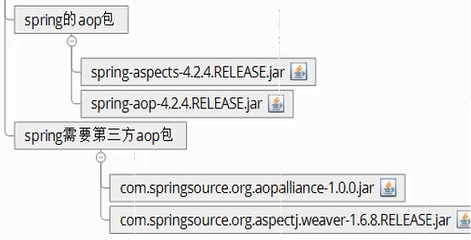spring再学习之AOP实操
一、spring导包

2、目标对象
public class UserServiceImpl implements UserService {
@Override
public void save() {
System.out.println("保存用户!");
//int i = 1/0;
}
@Override
public void delete() {
System.out.println("删除用户!");
}
@Override
public void update() {
System.out.println("更新用户!");
}
@Override
public void find() {
System.out.println("查找用户!");
}
}
3、准备通知
//通知类
public class MyAdvice {
/**
* 前置通知
*-目标方法运行前调用
*后置通知(如果出现异常不会调用)
*-目标方法运行之后调用
*环绕通知
*-在目标方法之前之后调用
*异常拦截通知
*-在目标方法运行之后调用
*后置通知(无论是否出现异常都会调用)
*目标方法运行后调用
*/ //前置通知
public void before() {
System.out.println("这是前置通知!!!");
}
//后置通知通知
public void afterReturning() {
System.out.println("这是后置通知(如果出现异常不会调用)!!!");
}
//环绕通知
public Object around(ProceedingJoinPoint pjp) throws Throwable {
System.out.println("这是环绕通知之前的部分");
Object proceed = pjp.proceed();//调用目标方法
System.out.println("这是环绕通知之后的部分");
return proceed;
}
//异常通知
public void afterException() {
System.out.println("出事了,出现异常了");
}
//后置通知
public void after() {
System.out.println("出事了,出现异常了");
} }
4、配置进行织入
<?xml version="1.0" encoding="UTF-8"?> <beans xmlns:xsi="http://www.w3.org/2001/XMLSchema-instance"
xmlns="http://www.springframework.org/schema/beans"
xmlns:p="http://www.springframework.org/schema/p"
xmlns:context="http://www.springframework.org/schema/context"
xmlns:aop="http://www.springframework.org/schema/aop"
xsi:schemaLocation="http://www.springframework.org/schema/beans
http://www.springframework.org/schema/beans/spring-beans-4.2.xsd
http://www.springframework.org/schema/context
http://www.springframework.org/schema/context/spring-context-4.2.xsd
http://www.springframework.org/schema/aop
http://www.springframework.org/schema/aop/spring-aop-4.2.xsd "> <!-- 导入安aop(约束)命名空间 -->
<!-- 1.配置目标对象 -->
<bean name="userServiceTarget" class="cn.itcast.service.UserServiceImpl"></bean>
<!-- 2.配置通知对象 -->
<bean name="myAdvice" class="cn.itcast.d_springaop.MyAdvice"></bean>
<!-- 3.配置将通知织入目标对象 -->
<aop:config>
<!-- 配置切入点
书写expression="execution(* cn.itcast.service.*ServiceImpl.*(..))"
public void cn.itcast.service.UserServiceImpl.save()
一般 public省略掉 ,一般对返回值不做要求用*表示,类下的放大,用*表示全部的方法
* cn.itcast.service.UserServiceImpl.*()
继续演化..表示不对参数有任何要求
* cn.itcast.service.UserServiceImpl.*(..)
继续演化,不对集体的类有要求
* cn.itcast.service.*ServiceImpl.*(..)
继续演化 ,不只找service中的类而且找子包
* cn.itcast.service..*ServiceImpl.*(..)
-->
<aop:pointcut expression="execution(* cn.itcast.service.*ServiceImpl.*(..))" id="pc"/>
<aop:aspect ref="myAdvice">
<aop:before method="before" pointcut-ref="pc"/>
<aop:after-returning method="afterReturning" pointcut-ref="pc"/>
<aop:around method="around" pointcut-ref="pc"/>
<aop:after method="after" pointcut-ref="pc"/>
<aop:after-throwing method="afterException" pointcut-ref="pc"/>
</aop:aspect> </aop:config> </beans>
测试:
/**
* @RunWith :帮我们创建容器
* @ContextConfiguration :指定创建容器时使用哪个配置文件
* @author zws
*
*/
@RunWith(SpringJUnit4ClassRunner.class)
@ContextConfiguration("classpath:cn/itcast/e_annotationaop/applicationContext.xml")
public class Demo { @Resource(name="userServiceTarget")
private UserService us; @Test
public void fun1(){
us.save();
} }
结果:
这是环绕通知之前的部分
这是前置通知!!!
保存用户!
这是环绕通知之后的部分
出事了,出现异常了
这是后置通知(如果出现异常不会调用)!!!
注解配置:
//通知类
@Aspect
//表示该类是一个通知类
public class MyAdvice { //前置通知
// -目标方法运行前调用
//后置通知(如果出现异常不会调用)
// -目标方法运行之后调用
//环绕通知
// -在目标方法之前之后调用
//异常拦截通知
// -在目标方法运行之后调用
//后置通知(无论是否出现异常都会调用)
//前置通知
@Before("execution(* cn.itcast.service.*ServiceImpl.*(..))")
public void before() {
System.out.println("这是前置通知!!!");
} //后置通知通知
@AfterReturning("execution(* cn.itcast.service.*ServiceImpl.*(..))")
public void afterReturning() {
System.out.println("这是后置通知(如果出现异常不会调用)!!!");
} //环绕通知
@Around("execution(* cn.itcast.service.*ServiceImpl.*(..))")
public Object around(ProceedingJoinPoint pjp) throws Throwable {
System.out.println("这是环绕通知之前的部分");
Object proceed = pjp.proceed();//调用目标方法
System.out.println("这是环绕通知之后的部分");
return proceed;
}
//异常通知
@AfterThrowing("execution(* cn.itcast.service.*ServiceImpl.*(..))")
public void afterException() {
System.out.println("出事了,出现异常了");
}
//后置通知
@After("execution(* cn.itcast.service.*ServiceImpl.*(..))")
public void after() {
System.out.println("出事了,出现异常了");
} }
配置:
<?xml version="1.0" encoding="UTF-8"?> <beans xmlns:xsi="http://www.w3.org/2001/XMLSchema-instance"
xmlns="http://www.springframework.org/schema/beans"
xmlns:p="http://www.springframework.org/schema/p"
xmlns:context="http://www.springframework.org/schema/context"
xmlns:aop="http://www.springframework.org/schema/aop"
xsi:schemaLocation="http://www.springframework.org/schema/beans
http://www.springframework.org/schema/beans/spring-beans-4.2.xsd
http://www.springframework.org/schema/context
http://www.springframework.org/schema/context/spring-context-4.2.xsd
http://www.springframework.org/schema/aop
http://www.springframework.org/schema/aop/spring-aop-4.2.xsd "> <!-- 导入安aop(约束)命名空间 -->
<!-- 1.配置目标对象 -->
<bean name="userServiceTarget" class="cn.itcast.service.UserServiceImpl"></bean>
<!-- 2.配置通知对象 -->
<bean name="myAdvice" class="cn.itcast.e_annotationaop.MyAdvice"></bean>
<!-- 3.配置将通知织入目标对象 使用注解完成织如-->
<aop:aspectj-autoproxy></aop:aspectj-autoproxy>
</beans>
测试:
/**
* @RunWith :帮我们创建容器
* @ContextConfiguration :指定创建容器时使用哪个配置文件
* @author zws
*
*/
@RunWith(SpringJUnit4ClassRunner.class)
@ContextConfiguration("classpath:cn/itcast/e_annotationaop/applicationContext.xml")
public class Demo { @Resource(name="userServiceTarget")
private UserService us; @Test
public void fun1(){
us.save();
} }
结果;
这是环绕通知之前的部分
这是前置通知!!!
保存用户!
这是环绕通知之后的部分
出事了,出现异常了
这是后置通知(如果出现异常不会调用)!!!
spring再学习之AOP实操的更多相关文章
- spring再学习之AOP事务
spring中的事务 spring怎么操作事务的: 事务的转播行为: 事务代码转账操作如下: 接口: public interface AccountDao { //加钱 void addMoney( ...
- spring再学习之AOP准备
一.aop思想: 横向重复,纵向抽取 1.乱码 2.事务管理 3,action 二.spring能够为容器中管理的对象生成代理对象 1.spring能帮我们生成代理对象 2.spring实现aop的原 ...
- spring再学习之设计模式
今天我们来聊一聊,spring中常用到的设计模式,在spring中常用的设计模式达到九种. 第一种:简单工厂 三种工厂模式:https://blog.csdn.net/xiaoddt/article/ ...
- Spring基础学习(四)—AOP
一.AOP基础 1.基本需求 需求: 日志功能,在程序执行期间记录发生的活动. ArithmeticCalculate.java public interface ArithmeticCal ...
- Spring框架学习06——AOP底层实现原理
在Java中有多种动态代理技术,如JDK.CGLIB.Javassist.ASM,其中最常用的动态代理技术是JDK和CGLIB. 1.JDK的动态代理 JDK动态代理是java.lang.reflec ...
- Spring框架学习05——AOP相关术语详解
1.Spring AOP 的基本概述 AOP(Aspect Oriented Programing)面向切面编程,AOP采取横向抽取机制,取代了传统纵向继承体系重复性代码(性能监视.事务管理.安全检查 ...
- spring框架学习(三)——AOP( 面向切面编程)
AOP 即 Aspect Oriented Program 面向切面编程 首先,在面向切面编程的思想里面,把功能分为核心业务功能,和周边功能. 所谓的核心业务,比如登陆,增加数据,删除数据都叫核心业务 ...
- spring再学习之注解
1.使用注解配置spring <?xml version="1.0" encoding="UTF-8"?> <beans xmlns:xsi= ...
- spring再学习之配置详解
applicationContext.xml文件配置: bean元素: <?xml version="1.0" encoding="UTF-8"?> ...
随机推荐
- go语言循环变量
阅读go语言圣经第五章第六节介绍到了捕获迭代变量 package main import ( "fmt" ) func main() { var lis []func() for ...
- layui表格数据统计
//执行一个 table 实例 table.render({ elem: '#demo' ,height: 420 ,url: '/demo/table/user/' //数据接口 ,title: ' ...
- Flutter--Flutter中Widget、App的生命周期
前言 在App的开发过程中,我们通常都需要了解App以及各个页面的生命周期,方便我们在App进入前台时启动一些任务,在进入后台后暂停一些任务.同时,各个页面的生命周期也很重要,每个页面消失时要做一些内 ...
- C指针的这些使用技巧,掌握后立刻提升一个Level
这是道哥的第016篇原创 关注+星标公众号,不错过最新文章 目录 一.前言 二.八个示例 1. 开胃菜:修改主调函数中的数据 2. 在被调用函数中,分配系统资源 2.1 错误用法 2.2 正确用法 3 ...
- What is :: (double colon) in Python when subscripting sequences?
What is :: (double colon) in Python when subscripting sequences? 15 Extended Slices https://docs.pyt ...
- JAD 反编译
自动拆装箱 对于基本类型和包装类型之间的转换,通过xxxValue()和valueOf()两个方法完成自动拆装箱,使用jad进行反编译可以看到该过程: public class Demo { publ ...
- springboot配置rabbitmq
一.消息生成者 1.1消息生成者配置 1.2 消息发送端代码 1.3 创建交换机,队列,并建立关系 二.消费者 2.1消费者 三.限流配置 3.1配置文件 #在单个请求中处理的消息个数,他应该大于等于 ...
- 阿里云服务器centos7,docker部署mysql+Redis+vue+springboot+Nginx+fastdfs,亲测可用
一.购买云服务器 我是今年双十一期间在阿里云购买的服务器, 简单配置2核_4G_40G_3M,三年用了不到800块,不过当时我记得腾讯云更便宜,个人感觉,阿里的云服务器更加的稳定, 毕竟身经百战, 经 ...
- maven pom文件的 name 标签 和 url标签到底是什么作用
- java.util.List.subList使用注意
List<E> subList(int fromIndex, int toIndex); 它返回原来list的从[fromIndex, toIndex)之间这一部分的视图,之所以说是视图, ...
